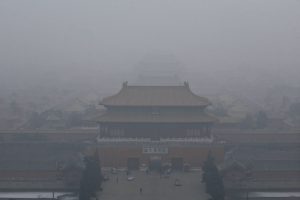In the months leading up to the just-completed United Nations-led climate talks in Indonesia, a great deal of pressure built up for the meeting to produce a definitive roadmap by 2009 for an international climate-change framework after the current phase of the Kyoto Protocol ends in 2012. Numerous high-level global events and conferences, a flood of media coverage and a deluge of analysis from NGOs, business and government bodies were topped off with the awarding of the Nobel Prize to Al Gore and the Intergovernmental Panel on Climate Change. With this increased publicity generating sky-high expectations among many, a “post-Bali” let-down was almost inevitable, with negotiators, scientists, journalists and the public disappointed with its less-than-perfect results.
On the ground at the UN Framework Convention on Climate Change Conference of the Parties, delegates worked feverishly into the night. As negotiations took an acrimonious turn on the last day, UN secretary general Ban Ki-moon made a return visit to ensure the conference was not a “failure”. There was strong disagreement between the EU and US over plans for emissions reduction targets. The real problem, however, was that mandatory targets were never actually on the table at Bali – too many countries were simply unready for them. In the end, delegates agreed to consider making “measurable, reportable and verifiable nationally appropriate mitigation actions” a part of their post-2012 mitigation strategy.
However, the four building blocks of a post-2012 framework—adaptation, mitigation, technology, and financing—did make progress in Bali. There was increased attention on adaptation and forestry in particular, which resulted in some useful measures. The discussion moved forward on technology transfer and financing mechanisms, though not as far as many had hoped. Delegates also made progress on mitigation measures, with global sectoral emissions targets for certain industries now on the table for further discussion.
The future of Asia
These outcomes are important for Asia. Deforestation and adaptation are two of its most important issues, but up to this point in the Kyoto process they had taken a backseat to mitigation. Moreover, China and India, which the developed world have repeatedly called on to make a meaningful commitment in the second period of the Kyoto Protocol, showed that they are taking the issue more seriously. China and India presented their national climate-change strategies. Both countries have also created high-level cross-ministerial national bodies to address global warming and are beginning to implement policy measures by setting targets on renewables and energy intensity.
However, China and India are unready to make commitments to match developed countries. Throughout the conference they emphasised the principle of “common but differentiated responsibilities”—that those with greater historical responsibility and greater capacity should do more to address climate change—as well as the need for a flexible future framework that includes deep emissions cuts and technology transfer from major emitters. Many voices in the west are still calling for a treaty with strong enforcement mechanisms and mandatory commitments—although not necessarily economy-wide targets—for all major emitters. The precise wording of the Bali decision leaves the debate open on this point, and will no doubt be a point of contention over the next two years.
Developing countries in Asia still resist binding targets because they fear their economic growth will suffer. Most Asian countries are only just beginning to understand the risks of climate change and are in the early stages of creating national strategies. The difficulty of forecasting economic growth patterns in the region also makes setting accurate long-term emissions reduction targets very challenging. But despite this, huge projected increases in Asian emissions, the extreme vulnerability of countries in the region and recent scientific reports showing the increased potential for catastrophic impacts mean it is necessary to produce meaningful results for a second commitment period.
Climate mechanisms
Climate change may not be a high priority issue for many Asian countries, but sustainable development policies already have a broad appeal. Reforming the Clean Development Mechanism (CDM), under which developed countries with greenhouse-gas reduction commitments invest in projects to reduce emissions in developing countries, could be a step in the right direction. A Sustainable Development Policies and Measures (SD-PAMs) approach would see developing countries pledging specific policy commitments that reduce greenhouse-gas emissions while benefiting economic growth. These voluntary commitments could then generate Certified Emissions Reductions (CERs), which can be traded. The wording of the Bali roadmap supports this approach, calling for mitigation measures from developing countries to be “in the context of sustainable development”. Furthermore, CERs from less desirable, much-criticised projects, such as those involving hydrofluorocarbons (HFCs), could be “discounted” from the mechanism. In these ways, the CDM could be re-engineered to reduce global greenhouse-gas emissions, rather than shift them from the industrialised countries to the developing world.
Many Asian countries plan to address energy security concerns by relying on extensive domestic resources of coal. However, domestic policies in China and India demonstrate there is increasing political support for renewable energy in Asia. The Bali roadmap calls on developed countries to assist developing countries in mitigation efforts of this nature with technology transfer and financing. Working out the specifics of this support will be one of the main issues to discuss over the next two years. Stepping up current co-operation initiatives, dramatically increasing research-and-development funding for projects such as carbon capture and storage, and lowering trade barriers for environmental technologies are all vital options for decoupling development from emissions growth and improving energy security. It will also be useful to set-up an international “clearing house” of technologies to fight climate change. This will help decision-makers understand and choose the appropriate technologies for national mitigation plans – a complex area often requiring expert assistance.
“Menu” of options
Many countries around the world, including those in Asia, are not ready to take on binding targets. However, many of these nations are acknowledging the risk of climate change and realising they should accept some form of targets. The Bali roadmap reflects this reality. The important task is now to ensure there is a range of meaningful options for developing countries to adopt. It is critical that developing countries also prepare for increasing future responsibility by building domestic capacity and institutions for effective national planning, implementation, monitoring and enforcement of climate-change policy.
The post-2012 framework can promote this acceptance of obligations and domestic capacity building with two main strategies: firstly, by aligning sustainable development goals with greenhouse-gas reduction through a reformed CDM that has a “menu” of options, including adaptation policy, forest-management policy and “discounted” CERs; secondly, by addressing energy-security concerns with dramatically increased technology transfer and co-operation. Developed countries should match this increase in responsibility by reducing their emissions more aggressively, building co-ordinated and multi-dimensional governance frameworks, increasing collaboration on research, encouraging investment in alternative energy, continuing to refine and expand carbon markets and following through with the technology transfer and financing for developed countries urged in the Bali roadmap.
In 2008, building on Bali’s progress will be important so that greater things can be achieved at the next year’s COP15 meeting in Copenhagen. At that time, industrialised countries must work with developing nations to build their national capacities to address climate change. Once this capacity has been built to an adequate level, and if obligations are constructed in the context of sustainable development and energy security, developing countries may be ready to accept their part of a global climate-change commitment.
Christine Loh is the CEO of Civic Exchange
Andrew Stevenson is a US Fulbright Scholar studying in Hong Kong




